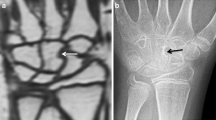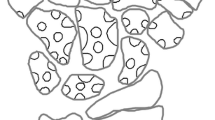Abstract
Objective: To characterize the features and prevalence of radiographic abnormalities of the wrist in children with Kashin-Beck disease (KBD) and to determine whether the presence of radiographic abnormalities in the wrist correlates with the severity of KBD. Design and patients: Two hundred and eight posteroanterior radiographs of the right hand (including wrist) in children with KBD, ranging in age from 4 to 11 years (mean age 7.7 years), from endemic areas of China were reviewed. Carpal bony margins were evaluated for blurring, thinning, irregularity with and without sclerosis, interruption, depression or destruction. The radiocarpal, intercarpal and carpometacarpal joints were assessed for widening or narrowing. The severity of the disease was graded using the hand criteria from the Chinese Radiographic Criteria of KBD Diagnosis, which classifies the following five types according to the location of the hand involved: I, metaphysis; II, diaphysis; III, I+II; IV, metaphysis and epiphysis; V, II+IV. Results: Of the 208 children, 95 had abnormalities in the hand but not in the wrist; 108 had both hand and wrist abnormalities; only five had abnormal wrist findings without any hand abnormalities. Of the 108 cases with wrist abnormalities, all the carpal bones were involved in 33 cases, of which the hand types were either IV or V. However, any individual carpal bone, or combination of bones, may become involved. The carpal bones most likely to show abnormalities were the capitate and the hamate (93%), followed by the triquetrum (31%), the lunate (9%), the scaphoid (6%), and the trapezoid and the trapezium (5%). The pisiform bones were not evaluated because they cannot be seen on the overlapping posteroanterior radiographs. The most commonly involved carpal joint was the midcarpal joint (42%). Conclusions: Recognizing carpal abnormalities on radiographs is helpful for the diagnosis of KBD and the evaluation of the severity of the disease. The more severe the KBD, the more likely that the carpal bones will be involved. The capitate and hamate are frequently affected if the disease involves the carpal bones.
Similar content being viewed by others
Author information
Authors and Affiliations
Additional information
Electronic Publication
Rights and permissions
About this article
Cite this article
Yu, W., Wang, Y., Jiang, Y. et al. Kashin-Beck disease in children: radiographic findings in the wrist. Skeletal Radiol 31, 222–225 (2002). https://doi.org/10.1007/s00256-002-0475-2
Received:
Revised:
Accepted:
Published:
Issue Date:
DOI: https://doi.org/10.1007/s00256-002-0475-2




